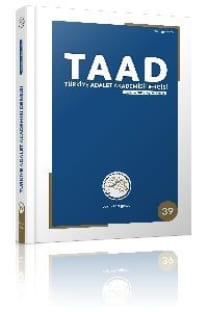YATIRIM YOLUYLA İKAMET VE VATANDAŞLIK
Bu makale, yatırım programlarıaracılığıyla ikamet izni ve vatandaşlıkkazanılmasını eleştirel yöndenincelemektedir. Her ne kadar, pek çokkişi bu tür programları onaylamasada, devletler giderek kendiyatırımprogramları kabul etmektedir.Üstelik bunlardan bazıları ülkelerindeyatırım devam ettiği sürece herhangibaşka bir şart aramaksızın kendivatandaşlıklarını yabancılara vermekteistekli görünmektedir. Bununla birlikteyatırım programlarının [vatandaşlıkkazandırma niteliğinin] ahlaki/hukukimülahazalara uygunluğunun ötesindebaşka bazı yan etkileri bulunmaktadır.Dolayısıyla bunların özellikleuluslararası vergi sistemi üzerindekisonuçları tartışmaya açılmalıdır.
Residence and Citizenship Through Investment
This Article critically examines the acquisition of residence permit and citizen ship through investment programmes. Event hough most of people raise eye brows to these programmes, States are in creasingly adopting their own programmes. Besides, some of them seem to be willing to be stow their citizen ship to the immigrants with out searching any extra conditions, as long asinvestments are sustained on their soil. However, these investment programmes havesome other side-effects beyond their compatibility with ethical/legal considerations. Therefore, one should discuss their consequences on international tax regime.
___
- ADIM, Leila: Between Benefit and Abuse: Immigrant Investment Programs (2017-2018), St. Lois U.L.J., Vol.6, 121.
- BOSNIAK, Linda: The Citizen and the Alien Dilemmas of Contemporary Membership, Princeton: Princeton University Press, 2006.
- BRAUNER, Yariv: Whatthe BEPS? (2014) Florida Tax Review, Vol.16, No.2, 55- 115.
- CAMPBELL, Colin: Taxpayer Migration, Canadian Bar Association, 2011 TaxLawforLawyers (May 29-June 3, 2011), NiagaraFalls, Ontorio, 1-82.
- CAPORASO, James A.:Changes in the Westphalian Order: Territory, Public Authority, and Sovereignty (Summer 2000), International Studies Review, Vol.2, No.2, 1-28.
- CHRISTIANS, Allison: Buying In: Residence and Citizenship by Investment (2017), Saint Louis UniversityLawJournal, Vol.62, 1-22.
- COOK-MARTIN, David: The Scramblefor Citizens: Dual Nationality and State Competition for Immigrants, Palo Alto, CA: Stanford University Press 2013.
- DHARMAPALA, Dhammika: What Do We Know About Base Erosionand Profit Shifting?, A Review of theEmpirical Literature, CESIFO Working Paper, No.4612, Category 1: Public Finance, January 2014, 1-29.
- DŽANKIĆ, Jelena: Investment-based Citizenship and Residence Programmes in the EU, European University Institute, Robert Schuman Centrefor Advanced Studies, European Union Democracy Observatory on Citizenship, EUI Working Paper RSCAS 2015/08, 1-25.
- FAIST, Thomas: Dual Citizenship in Europe: From Nationhood to Societal Integration, London: Routledge 2007.
- FAIST, Thomas/ GERDES Jurgen: Dual Citizenship in an Age of Mobility, Migration Policy Institute, Bielefeld University 2008, 1-21.
- GADŽO, Stjepan/KLEMENČIĆ, Irena: Effective International Information Exchange As A Key Element of Modern TaxSystems: Promisesand Pitfalls of the OECD’s Common Reporting Standard (2017), Public Sector Economics Vol.41, No.2, 208-226.
- HANSEN, Randall/ WEIL, Patrick: Dual Nationality; Social Rightsand Federal Citizenship in the U.S. and Europe; The Reinvention of Citizenship, New York: Berghan Books 2002.
- HOWARD, Marc M.:Variation in Dual Citizenship Policies in the Countries of the EU, International Migration Review, Vol.39, No. 3, 697-720.
- KORCELLI, Piotr: CurrentIssues Related to Immigration and Citizenship: The Case of Poland in From Aliens to Citizens: Redifining the Status of Immigrantsin Europe (ed. Rainer BAUBÖCK), Brookfield: Ashgate, 121-133.
- KOSLOWSKI, Rey: Migrants and Citizens: Demografic Change in the European State System, Cornell University Press 2000.
- LISTER, Ruth: Why Citizenship; Where, When and How Children (2007), Theoretical Inquiries in Law, Vol.8, 693-718.
- MARSHALL, Thomas H.: Class, Citizenship and Social Development (Greenwood Press 1973) (firstpublished in 1950)
- MUNDLAK, Guy: Industrial Citizenship, Social Citizenship, Corporate Citizenship: I JustWant My Wages (2007), Theoretical Inquiries in Law, Vol.8, 719-748.
- OECD, Taxand Employment, OECD Tax Policy Studies (2011), No.21.
- OECD, Standard forAutomatic Exchange of Financial Account Information (2014), Part 1. Introduction and Overview No.8.
- POGONYI, Szabolcs: Dual Citizenship and Sovereignty (2011), Nationalities Papers, Vol.39, Issue 5, 685-704.
- ROSTEK, Karolina/ DAVIES, Gareth: The Impact of Union Citizenship on National Citizenship Policies (2007), Tulane European&CivilLaw Forum, Vol.22, 1-54.
- SHACHAR, Ayelet: Dangerous Liaisons: Money and Citizenship in Should Citizenship Be ForSale? (ed. Ayelet Shachar, Rainer BAUBÖCK), EUI Working Paper, RSCAS, 2014/01, 3-8.
- SPIRO, Peter J.: Dual Nationality and the Meaning of Citizenship (1997), Immigration&Nationality Law Review, Vol. 46, No.4, 1411-1485.
- SPIRO, Peter J.:Citizenship Overreach (2017), Michigan Journal of International Law, Vol.38, 167-191.
- WALTER, Michael: The Bancroft Conventions: Second-Class Citizenship for Naturalized Americans (Fall 1978), International Lawyer, Vol.12, No.4, 825- 833.
- ZAWADA, Przemyslaw: Dual Citizenship in Poland andIsrael: Selected Legal Aspects in a Comparative Perspective (2018), Polish Political Science Yearbook, Vol. 47, Issue 2, 302-318.
- https://www.atu.li. (erişim tarihi: 6.7.2018)
- https://www.chetcuticauchi.com. (erişim tarihi: 6.7.2018)
- https://www.column.global-labour-university.org. (erişim tarihi: 30.6.2018)
- https://www2.deloitte.com. (erişim tarihi: 17.3.2019)
- https://www.dunya.com. (erişim tarihi:3.7.2018)
- https://www.lexology.com. (erişim tarihleri: 26.6.2018, 3.7.2018, 5.7.2018, 10.7.2018)
- https://www.loc.gov. (erişim tarihi: 6.7.2018)
- https://www.ukba.homeoffice.gov.uk. (erişim tarihi: 6.7.2018)
- ISSN: 1309-6826
- Başlangıç: 2010
- Yayıncı: Türkiye Adalet Akademisi
Sayıdaki Diğer Makaleler
HUKUKTA “ÖZ” ARAYIŞLARI VE İSLAM HUKUKUNUN METAFİZİK KARAKTERİ
Okan YILDIZ, Bayram UZUN, Yakup Emre ÇORUHLU
YATIRIM YOLUYLA İKAMET VE VATANDAŞLIK
Tuba YÜCEER KARDEŞ, Elif GÖKÇEARSLAN ÇİFCİ, Rumeysa AKGÜN
HEKİMİN EMBRİYONİK KÖK HÜCRE NAKLİNDEN DOLAYI KİŞİSEL SORUMLULUĞU
TÜRK HUKUKUNDA ÜRÜN SORUMLULUĞU ÜZERİNE OLAN VE OLMASI GEREKEN HUKUKA DAİR GENEL DÜŞÜNCELER
HEKİMİN HATALI TIBBİ UYGULAMAYA BAĞLI HUKUKİ SORUMLULUĞU
ANONİM ŞİRKETLERDE İMTİYAZLI PAY SAHİPLERİ ÖZEL KURULUNUN İŞLEYİŞİ
RÖDÖVANS SÖZLEŞMESİNİN MADEN HUKUKUNDAKİ YERİ VE MALİ YÜKÜMLÜLÜKLER
